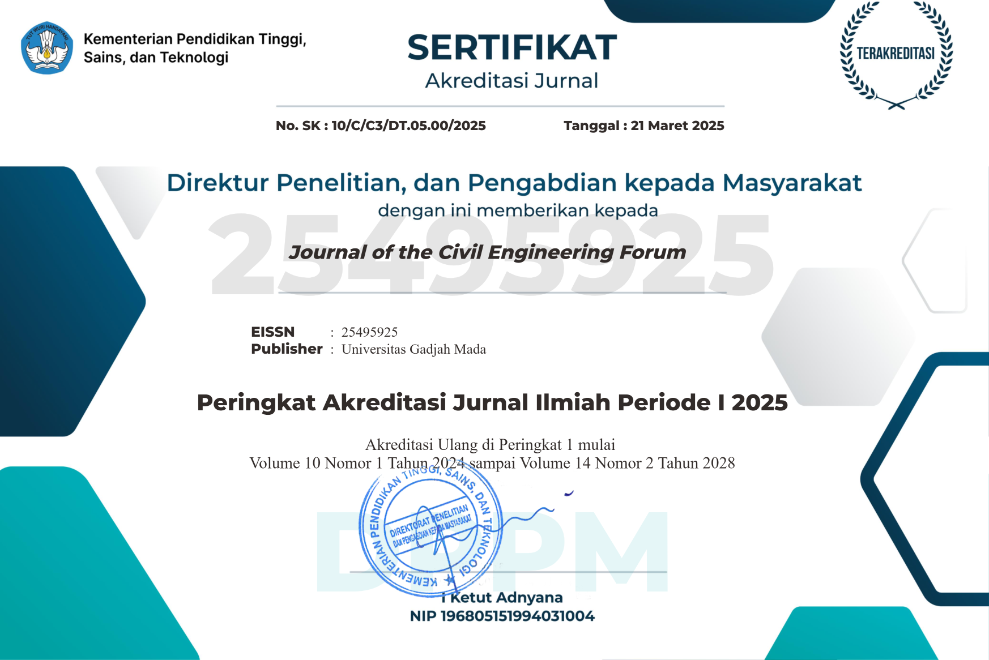Experimental Study of Sand-Cement Brick with Expanded Polystyrene Beads and Silica Fume as Partial Replacement Materials
Abstract
The construction industry is growing fast alongside the growth of the economy and the population. As one of the major building materials, brick is in high demand for construction purposes. The continuous growth will eventually lead to a shortage of raw materials in long run, such as sand and Ordinary Portland cement. This issue could be resolved by utilizing the waste materials, Expanded Polystyrene (EPS) beads and Silica Fume (SF), in replacement of sand and cement in the production of bricks, respectively. In this study, 120 specimens were produced with EPS beads removed 10% to 15% of sand while SF removed 10% to 20% of cement. The cement-to-sand ratio and water-to-cement ratio were 1:2.5 and 0.5 respectively. The performance of bricks was analyzed in the aspect of compressive strength, density, water absorption, and strength to weight ratio (s-w ratio). EPS beads were found to reduce the compressive strength and density, while SF strengthen the mix thus compensating for the performance loss caused by EPS beads. For construction application, the EPS beads and SF with the replacement of 15% and 10% respectively, were recommended, as it achieved the minimum requirement of the industry.
References
ACI Committee 234 (2006). Guide for the use of silica fume in concrete. ACI Committee’, American Concrete Institute, 96, pp. 1–51.
Adrian, L. (2015). Sarawak scores high on foreign investments. Borneo Post Online. [online]. Available at: https://www.theborneopost.com/2015/05/23/sarawak-scores-high-on-foreign-investments/ [Accessed October 5, 2021].
Askar, L., Albarwary, I. and Askar, M. (2019). Use of expanded polystyrene (Eps) beads in silica-fume concrete. The Journal of the University of Duhok, 22(1), pp. 30–38.
ASTM International (2011a). ASTM C140 – 11a. Standard test methods for sampling and testing concrete masonry units and related units.
ASTM International (2011b). ASTM C1634-11. Standard Specification for Concrete Facing Brick.
BS 3921:1985 (1985). Specification for clay bricks. British Standards Institution. Available at: https://www.thenbs.com/PublicationIndex/docu ments/details?Pub=BSI&DocID=72040.
Bureau of Indian Standards (1992). IS 1077: 1992 Common burnt clay building bricks - specification.
Gawatre, D. W. and Vairagade, L. N. (2014). Strength characteristics of different types of bricks. International Journal of Science and Research, 3(10), pp. 2247–2252.
Kartini, K. et al. (2012). Development of lightweight sand-cement bricks using quarry dust, rice husk and kenaf powder for sustainability. International Journal of Civil and Environmental Engineering, 12(6), pp. 1–7.
Laoubi, H. et al. (2018). Study of a new plaster composite based on dune sand and expanded polystyrene as aggregates. The Open Civil Engineering Journal, 12(1), pp. 401–412.
Ling, J. H. et al. (2019). Properties of cement brick with partial replacement of sand and cement with oil palm empty fruit bunches and silica fume. Journal of the Civil Engineering Forum, 5(3), p. 289.
Ling, J. H., Lim, Y. T., Leong, W. K. and Sia, H. T. (2021a). Effects of adding silica fume and empty fruit bunch to the mix of cement brick.
Indonesian Journal of Computing, Engineering and Design (IJoCED), 3(1), 19–30.
Ling, J. H., Lim, Y. T., Leong, W. K., and Sia, H. T. (2021b). Utilization of oil palm empty fruit bunch in cement bricks. Journal of Advanced Civil and Environmental Engineering, 4(1), pp. 1-10.
Miled, K. et al. (2004). Compressive behavior of an idealized EPS lightweight concrete: Size effects and failure mode. Mechanics of Materials, 36(11), pp. 1031–1046.
Ramli Sulong, N. H., Mustapa, S. A. S. and Abdul Rashid, M. K. (2019). Application of expanded polystyrene (EPS) in buildings and constructions: A review. Journal of Applied Polymer Science, 136(20), pp. 1–11.
Stephen, N. (2017). No more plastics and polystyrene, please. Malaysiakini. [online]. Available at: https://www.malaysiakini.com/news/381960. [Accessed October 5, 2021].
Shi, G. et al. (2021). A novel thermal insulation composite fabricated with industrial solid wastes and expanded polystyrene beads by compression method. Journal of Cleaner Production, 279, p. 123420.
Xu, Y. et al. (2012). Mechanical properties of expanded polystyrene lightweight aggregate concrete and brick. Construction and Building Materials, 27(1), pp. 32–38.
Copyright (c) 2023 The Author(s)

This work is licensed under a Creative Commons Attribution-ShareAlike 4.0 International License.
Copyright is granted to authors for the purpose of providing protection for articles written to describe experiments and their results. JCEF will protect and defend the work and reputation of the author and are also willing to address any allegations of violation, plagiarism, fraud, etc. against articles written and published by JCEF. JCEF is published under the terms of the Creative Commons Attribution-ShareAlike 4.0 International License (CC BY-SA 4.0). The author holds the copyright and assigns the journal rights to the first publication (online and print) of the work simultaneously.







